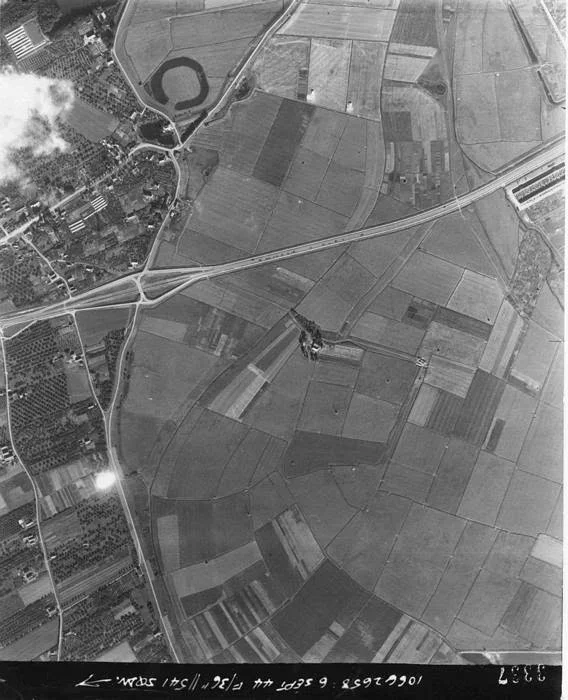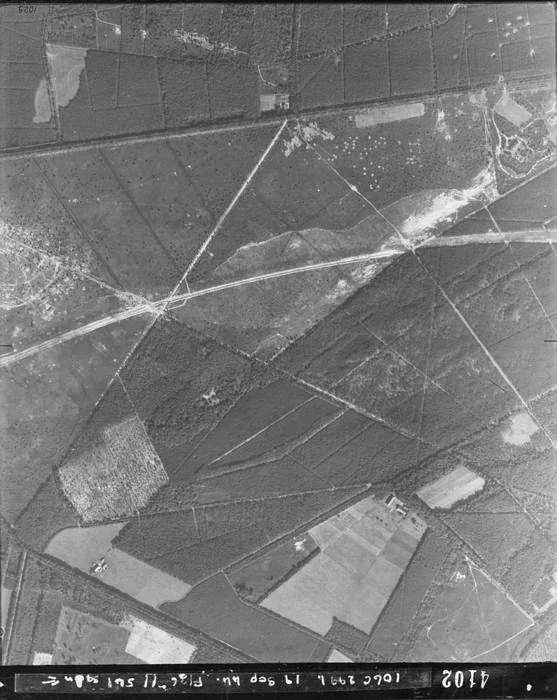One of the more contentious
issues which was, and has remained, from the planning for Operation
Market-Garden are the results of a photo-reconnaissance flight flown over the
Arnhem/Oosterbeek area just days prior to the start of the operation. The
photography was taken by a specifically modified Supermarine Spitfire PR Mk XI, believed to
be from one of the five RAF (No. 540-544 Sqn) Spitfire photo-reconnaissance squadrons based at RAF Benson. Probably No. 541 or 542 Sqn.
 |
| Restored Supermarine Spitfire PR Mk XI with invasion stripes |
 |
| Restored Supermarine Spitfire PR Mk XI in normal operational camouflage color scheme |
The Supermarine Spitfire PR Mk XI was
produced in greater numbers than any other PR variant, with over 470 produced
in total. It was based on the Mk IX fuselage, but with the extra fuel tanks of
the standard PR variants as well as wing mounted tanks. It entered service in
the summer of 1943. The PR Mk XI used a universal camera installation,
which allowed the cameras to be easily changed. This allowed a much wider
variety of cameras to be used, and as such it could undertake a great range of missions. Suffices that the aircraft would normally not have invasion stripes, providing at least a limited reduced level of visibility on the extremely dangerous missions. Being totally unarmed, speed was the aircraft's sole defense. Its top speed was 422 mph. Only the latest models of
Viewers familiar with the principles of photography will know that the longer the focal length of the camera lens, the larger the scale of the image; the larger the scale of the image, more detail and information for the photo-interpreter (PI) to extract. An example would be, a scale of 1:10000 would enable the PIs to see a man on a bicycle if the image was taken at 30,000 feet.
Another element that would also effect the information on the image would be the size of the film negative, the bigger the better, however, this had its drawbacks. The larger the negative, the larger the camera and the fewer image exposures in the camera magazine. Physical size of the film negatives were predominately three sizes. Initially 5”x 4” (127mm x 101.4mm) or 9”x 9” (Image size 7”x 7”), with later size being larger at 8”x 8” (215.9mm x 177.8mm).
Another factor was, the longer the focal-length of the lens the smaller area covered by the image negative and the last problem being, the lower that the reconnaissance aircraft flow to obtain the larger scaled imagery, the more dangerous it became for the pilot from enemy flak and fighter aircraft.
So to overcome these problems and obtain the best possible photograph of the target, they used various types of cameras fitted with various lenses of different focal-lengths.
Viewers familiar with the principles of photography will know that the longer the focal length of the camera lens, the larger the scale of the image; the larger the scale of the image, more detail and information for the photo-interpreter (PI) to extract. An example would be, a scale of 1:10000 would enable the PIs to see a man on a bicycle if the image was taken at 30,000 feet.
Another element that would also effect the information on the image would be the size of the film negative, the bigger the better, however, this had its drawbacks. The larger the negative, the larger the camera and the fewer image exposures in the camera magazine. Physical size of the film negatives were predominately three sizes. Initially 5”x 4” (127mm x 101.4mm) or 9”x 9” (Image size 7”x 7”), with later size being larger at 8”x 8” (215.9mm x 177.8mm).
Another factor was, the longer the focal-length of the lens the smaller area covered by the image negative and the last problem being, the lower that the reconnaissance aircraft flow to obtain the larger scaled imagery, the more dangerous it became for the pilot from enemy flak and fighter aircraft.
So to overcome these problems and obtain the best possible photograph of the target, they used various types of cameras fitted with various lenses of different focal-lengths.
F.8 Camera
Lenses:
Mk I & II - 20" focal-length f/6.3
Mk IIA - 20" focal-length f/5.6
Mk III - 36" focal-length f/6.3
Mk IV - 40" focal-length f/88
Mk I & II - 20" focal-length f/6.3
Mk IIA - 20" focal-length f/5.6
Mk III - 36" focal-length f/6.3
Mk IV - 40" focal-length f/88
Film
magazine:
Mk I - 100 exposures - 65ft
Mk II to IV - 250 exposures - 155ft
Mk II to IV - 250 exposures - 155ft
F.52 Camera
Lenses:
5", 8", 14", 20", 36" & 40"
Magazine:
500 exposures.
 |
| The F.52 Photo-Reconnaissance Camera |
 |
| Loading an F.8 photo-reconnaissance camera through the camera access port of a Spitfire PR Mk IG |
The flight took place on 13 September 1944, three days prior to the commencement of the operation. The single logged Arnhem sortie occurring that day was 106G/2872, flown by FO L.S. Dearling of No.541 Sqn in a Spitfire PR Mk XI, PL856. Maj Brian Urquhart, the Staff Intelligence Officer for 1st Airborne Corps (subsequently to become Deputy Secretary-General of the United Nations in the post-WWII years) who had specifically requested the reconnaissance mission, immediately presented (on 15 September) these low-altitude oblique photos showing Kampfpanzer Mk III and Mk IV tanks, to LtGen Frederick A. M. ‘Boy’ Browning. These tanks were elements of the II SS Panzer Corps (9th and 10th Waffen-SS Panzer Divisions) refitting in the area north and east of Arnhem. Browning summarily dismissed the evidence, and had his staff medical officer place Urquhart on medical leave for 'nervous strain and physical exhaustion'.
 |
| Maj Brian Urquhart, Intelligence Officer British1st Airborne Corps |
 |
| Kampfpanzer Mk IV; Note sleeve insignia of the tank crewmen. Tank's gun barrel stands out in sharp contrast if caught by a camera from above. |
Re-enactors in the uniforms of a Waffen-SS Panzer Division with a restored Kampfpanzer Mk IV in the tactical markings of the 1st Waffen-SS Panzer Division.
 |
| Kampfpanzer Mk IV; note tactical marking on front left of hull |
Another photograph of a restored Kampfpanzer Mk IV (probably the same tank) undergoing refitting.
 |
| Kampfpanzer Mk IV; note camouflage pattern on man in foreground and license plate on motorcycle fender |
Although not having those very same photographs in hand, I do have copies of others taken by a Spitfire PR Mk XI of RAF No. 541 Squadron on prior flights on 6 and 17 September 1944 over the Arnhem/Oosterbeek area. Specifically they include a sequence of the main road bridge, and some of the area north of Arnhem. First the area around the main road bridge, shot on 6 September 1944.
The following two photographs were taken on 18 September 1944 showing the complete destruction of SS-Hauptstrumführer Viktor Graebner's reconnaissance battalion at the north side of the main road bridge. Both photographs are attributed to Wg Cdr G.F.H. "Sandy" Webb (attached to RAF HQ 34 Wing) however flying Spitfire PR XI (PL834) attached to RAF No. 16 Sqn. There remains some confusion as to whether the aircraft/squadron was stationed at RAF Hartford Bridge or RAF Northolt. The same aircraft subsequently crashed and was destroyed on 20 September 1944, attesting to the extreme danger of the missions.
Next are a series showing an east to west road under construction located north of Arnhem. Based on the annotations this series was shot on 17 September 1944, the commencement date of Operation Market-Garden.
I thought it might prove
interesting enough to present some of those photos to readers in order that
they could personally see the resolution available at the time to
photo-interpreters analyzing the footage. For those so inclined, the photos can
be copied off the blog page as jpgs, enlarged (limited), rotated (not required), and overlaid
in mosaics. Taken as individual high-speed sequential shots, the reader will
notice in aligning them at least a two-thirds overlap is present.
Real enthusiasts may even
want to take on the challenging task of matching the location of road depicted
in the second set of photographs with the map shown below (Hint: It is a road under construction which passes through Schaarsbergen).
Finally is a brief video of a totally restored fully operational Supermarine Spitfire PR Mk XI.
























2 comments:
good write up but name of 541 Sqn pilot miss spelt.It is Dearling.
Sincere thanks for the pick-up, and appreciate your interest in the blog.. As you may notice the spelling has been corrected.
Post a Comment